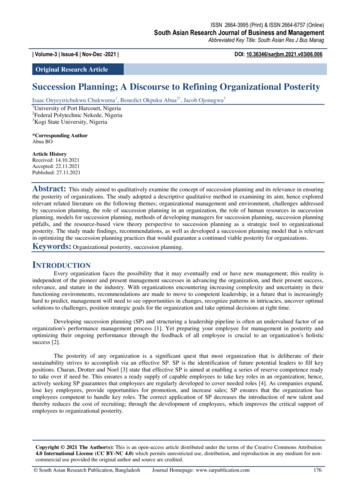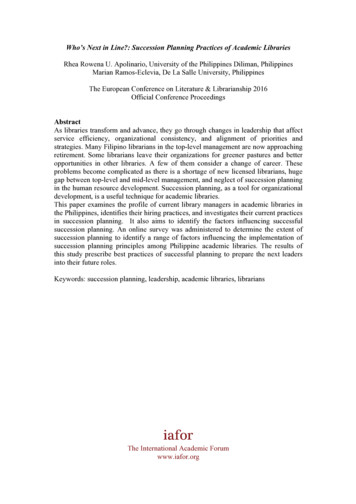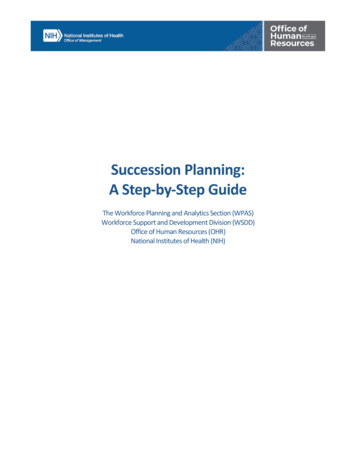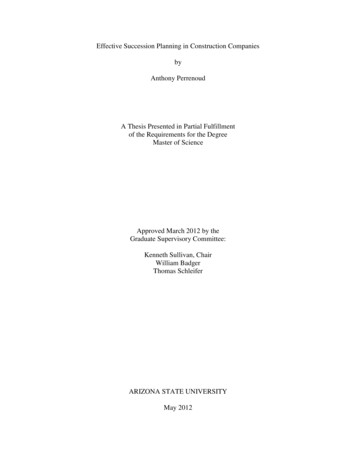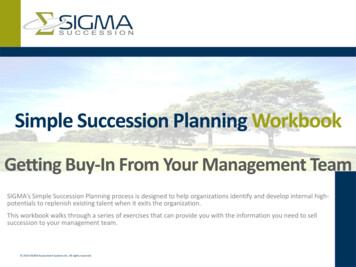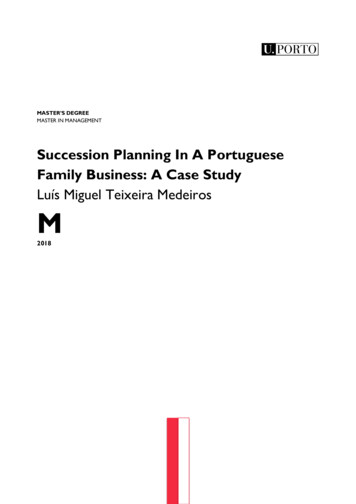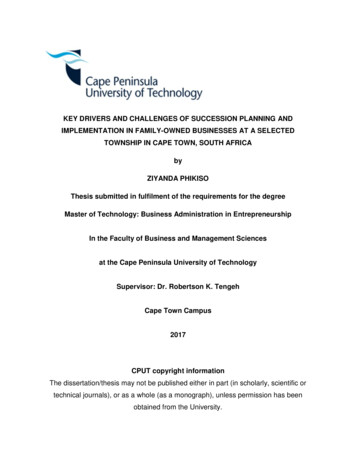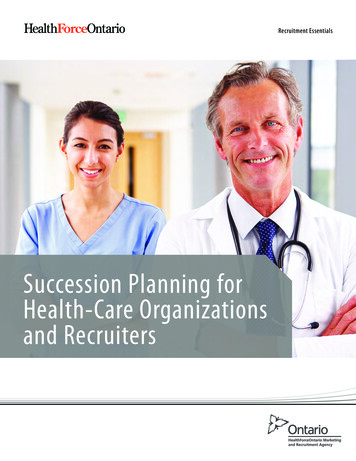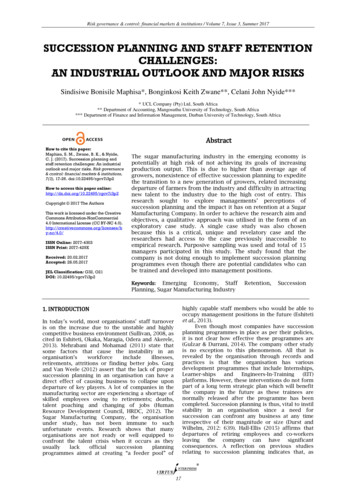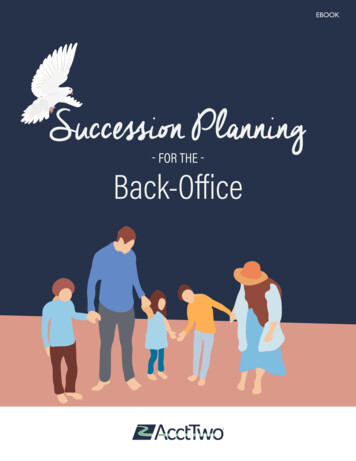
Transcription
EBOOKSuccession Planning- FORTHE-Back-Office
IF YOUFAIL TOPLAN, YOUPLANTOFAILImagine being on the leadership team and the Chief Financial Officer of your organization abruptly leaves.There’s no transition time. There’s no transfer of information. You are just left behind to pick up the pieces.How many months does that set you behind? How many months does that set the organization behind?It’s a mess and causes undue stress on you, your department, and the health of your organization. A propersuccession plan could not have predicted this situation, but it would have given your organization a roadmapon where to go next.To give an example, in 2018, a faith-based organization lost one of their leaders unexpectedly. Theirinterim replacement stepped in but, was very unprepared for the change and not a good fit in the role.The organization quickly began to decline – managers lost motivation, finances were not well-controlled,programs lost steam, and the organization was in danger of losing funds for programs that helped employ,clothe, feed, and pray over those who benefit from their services. Two years later, the organization has madea complete 180 turnaround and is not just surviving but thriving, but the lack of planning and time spentdeveloping other staff to manage without their leader caused some deep pains and significant gaps inbeing able to serve their community for a significant period of time. The organization healed, but not until anextensive and expensive search was undertaken to find the right person to lead the organization through aturnaround. The organization’s failure to plan almost ended in total failure – not just for that position, but forthe entire organization.2
Without a succession plan in place to help mitigatethe aftershock , the organization suffered greatly. It isunfair to say that a succession plan would have remediedthe situation, but it would have helped provide clarityduring a chaotic time. The organization failed to plan, andthus planned to fail.In this eBook we will dig into succession planning anddiscuss why it is so important. We will provide stories andstatistical data to help you clearly understand the necessity of succession planning as we cover the followingtopics:I.II.III.IV.V.VI.VII.VIII.The Purpose of Succession PlanningThe Importance of Good LeadershipCulture Really MattersWhat You Need to Know About Hiring MillennialsHiring from WithinSuccession Planning for the Back-OfficeRed Flags to Watch Out ForWhat’s Next?3
THEPURPOSEOF SUCCESSIONPLANNINGThe purpose of succession planning is to have a plan inplace when someone within your organization leaves. Thiscould be a career change, retirement, or an immediatelife altering situation. Most of the time you can’t predictwhat’s going to happen, so having a succession plan inplace can help work through the chaos when somethingunexpected happens. Deloitte reports that while 86percent of leaders believe leadership succession planningis an “urgent” or “important” priority, only 14 percentbelieve they do it well. Similar to buying accountingsoftware, succession planning is a function that you onlydo a handful of times in your career. It is realistic to feelthat you don’t do it well if you don’t do it often. Among faith-based succession planning experts, such as William Vanderbloemen from Vanderbloemenand Todd Clark from Slingshot, it is believed that succession planning is done better in the board room andnot the nonprofit/church meeting room. “ I think it might be easier in the boardroom because leaderslive separate lives from the companies that they run. Faith-based leaders don’ t delineate life andwork , making it harder, and more emotional, to take a step back . You also need to have a great deal ofempathy for the family and congregation – it’s not just about the leader ’s next chapter, it’s everyone’snext chapter,” says Todd Clark, Senior Associate in Senior Leadership at Slingshot Group.4
There’s a family component in many nonprofitorganizations that isn’t as prevalent in for-profitbusinesses that adds emotion to the equation. Ministry isa calling that occupies round-the-clock attention and avast amount of spiritual energy. It’s only natural, in all thefaith-based organizations that I work with, that there isan emphasis on family as an organizational value.Family is a part of our faith. Ephesians 2:19 ESV: “Sothen you are no longer strangers and aliens, but youare fellow citizens with the saints and members of thehousehold of God.” When you work for a faith-basednonprofit organization, your entire family adopts themission and values of that organization. It is wherewe spread the word of God, ask for the gifts of God’sgrace, and provide a helping hand to those that needit. We pray together as an organization and as anextended family. So, the thought that one of our familymembers might leave us can sometimes be perceivedas unfathomable – even though it is a realistic possibilitythat requires a solid plan.5
THEIMPORTANCEOF GOODLEADERSHIPGood leadership matters. As an organization, your emotional intelligence is vital to the succession planningprocess. People work for people. “People are definitely a company’s greatest asset,” says Mary Kay Ash,CEO of Mary Kay cosmetics. “It doesn’t make any difference whether the product is cars or cosmetics. Acompany is only as good as the people it keeps.” I think back to every organization that I’ve ever been in ora part of and that sentiment is so true. People are so important. Relationships with people are what bindus, especially in faith-based organizations when our focus is on the good work we do with people andspreading the word of the Lord. Faith-based employees are stewards of the organization, no matter whichrole they are in.According to Neal Joseph in Outcomes Magazine, “Leadership challenges now require an extra somethingthat is often intangible. We tend to hire people to solve ‘technical’ problems in our organizations, when in factmany organizational issues that result from working in a post-modern cultural context require adaptive, nottechnical leadership.”It goes both ways; positive and negative. If you have a leader in place that is amazing, your team is morelikely to be happier and at least 11 percent more productive than a leader who is terrible. Think about thecurrent leaders at your organization and their staff, how happy do they seem? How well do they worktogether? A change from one leader can be welcomed or cause stress. A study by Everest College showedthat more than 80 percent of Americans are stressed about their jobs, and 75 percent of people said the moststressful aspect of their job is their immediate boss.6
“When I stepped into West Houston Assistance Ministriesas CEO, I walked into a mess. Morale was down. I needed to quickly make major changes. Things needed to get done,the right way. Over the past three years, I helped rejuvenatethe board, cleaned up operations, and implemented newpolicies and procedures. We are significantly biggerthan where we were three years ago. I credit twokey fundamentals to that success: modeling goodleadership and truly caring for my team, and authenticstorytelling. The latter is a more recent revelation.When COVID started, I started documenting how ourorganization has been helping people. So far, I’ve createdover 100 videos since the pandemic started. It has increasedawareness of the organization on local and national news and helped aid my communication to our staff,board, and influencers,” Mark Brown, CEO at West Houston Assistance Ministries.Turnover can impede a healthy functioning church. The average cost for replacing a midrange staff person is20 percent of their salary and up to 213 percent for leadership roles. Over time, this can have serious financialrepercussions.Earlier this year I attended the Outcomes Conference where I heard Dr. James Galvin give a presentationon Successful Leadership Transitions. In that session, he said that 27 to 46 percent of leadership transitionsfail. That’s 1 out 3 leadership transitions that just don’t work. Can your staff handle that stress? The mostexpensive hire you can ever make is hiring the wrong person.7
CULTUREREALLY MATTERSRomans 8:28 ESV: “And we know that for those who love God all things work together for good, for thosewho are called according to his purpose.” Faith-based organizations take great pride in the culture that theycultivate (rightfully so), and that shouldn’t be overlooked in the hiring process – especially for successionplanning. Deloitte found that at least 30 percent of newly hired executives fail in their first 18 months—mostlybecause of poor culture fit. So, a stronger organizational culture due to an enhanced ability to advanceleaders who embody the organization’s stated beliefs might be a better fit overall.“Culture really does matter, especially during a crisis,” says Mark Brown, CEO at West Houston AssistanceMinistries. “When COVID first hit Texas, I spent the first six weeks on the frontline. I got my hands dirty. Iwanted to show my team how much I cared for them. Great leadership is about setting the right culturethrough example. In a crisis, leaders need to be seen.”Some of the most successful succession planning I’ve seen has included all members of the staff. Withcomplete team involvement, it is more likely that the new leader will be a cultural fit. I asked our HR Manager,Amanda McNeil, about some of the tools we use at AcctTwo to help ensure that someone is a good culturalfit. “We use the DISC assessment at AcctTwo. It is a non-judgmental tool used for discussion of people’sbehavioral differences. It has been successful for our team and we’ve implemented it with all new hires. Itallows us to really understand how that person is going to work and how well they will work with our existingteam.”8
DISC assessments can help you improve: Self-Knowledge: Learn how you respond to conflict,what motivates you, what causes you stress, andhow you solve problems Building Relationships: Recognize thecommunication needs of team members Better Teamwork: Be able to teach productiveconflict Effective Management: Understand the dispositionsand priorities of employees/team members DISC isn’t the only tool out there. Culture Index andStyle of Influence (now Team Sight) are also greatoptions. “Culture is so important. We use Culture Indexat Concord Church and we used Style of Influenceat Preston Trail. It doesn’t necessarily gauge intellect,instead it measures whether or not someone willbe a good fit for your team and ensure that it is wellrounded,” said Tammy Bunting, CFO at Concord Church.Don’ t overlook the cultural component to successionplanning – remember people work for people.9
WHAT YOUNEEDTOKNOWABOUT HIRINGMILLENNIALS &GENERATIONZFaith-based organizations hire with their heart and people stay long-term because of their belief in themission. Career longevity is often expected and frequently rewarded – especially within certain generationalcircles. A recent report on the millennial generation reveals that 21 percent of millennials say they’ve changedjobs within the past year, which is more than three times the number of non-millennials who report the same.At the same time, Generation Z is growing into the workforce quickly and many who are in this generationare drawn to opportunities for service.When thinking about the future of your organization, consider what leadership roles are (or will be) available,how to keep your younger workforce engaged, and how you can implement a successful successionplanning process. “Engagement is absolutely the answer to employee retention, and the best way to engageyour employees is to let them know you’re invested in them,” said Ryan Ross, vice president of GlobalAlliances at Hogan. “ Tell them your plan for them within the organization, assign them mentors, and givethem learning opportunities.”“We were growing at an exponential rate, and in our early years, we overlooked the benefits of structuredprofessional development,” says Allison Patterson, Head of Learning & Development in the Center ofExcellence at AcctTwo. “Each department had its own standards, and we wanted to streamline the processand make on-boarding, performance reviews, and training more accessible, engaging, and meaningful.We also realized that now more than ever, we must adapt to the learning styles and motivators of a multigenerational workforce. What works for one group may not for another, so it’s essential to develop training ina variety of modalities.”10
According to Forbes, in less than 10 years, millennials will make up 75percent of the workforce. If you don’t have a Millennial recruiting strategy,now may be the time to implement one. Gen Z will not be far behind them,and the recruiting strategy for the two different generations may require twodifferent approaches.Common Millennial Traits in the Workforce: Entrepreneurial spirit Mission oriented: improving the greater good is very important to them Work life balance is essential – more than other generations beforethem, they want to spend time with friends and family Bright and adaptive personalities Team-oriented and collaborative Open to feedback Common Generation Z Traits in the Workforce: Entrepreneurial spirit Independent and self-directed Creative problem-solvers Comfortable with minimal instructions Eager for stability Comfortable receiving feedbackThese two up-and-coming generations have many positive attributes that often get overshadowed bynegative perceptions. According to The Connected Generation, Millennials are longing to make adifference – when young adults engage with a community of worship, they’re looking for concreteteaching, opportunities to fight injustice, and friends to join them along the way. Generation Z wantsto do something that matters, but they also are finding new and faster ways to accomplish the same goals,creating opportunities for more time and energy to be poured more into your mission than just your backoffice. Your organization could be that cornerstone in their mission as it has been for you.Perhaps what’s best about these two generations is that they will reach any bar you set for them, andboth generations will want to grow with you. If you tell them how they need to grow in order to build theircareer and further your mission, and you provide honest and clear feedback, they will find a way to preparethemselves, making succession planning a more collaborative and transparent process.11
HIRINGFROMWITHINSometimes hiring from within is the best option, especially if organizational culture is very important to you.You already know how that person fits, but you need to be careful about promoting only high achievers.Research shows that only 30 percent of current high performers could step into a leadership role, and mostemployees (more than 90 percent) would have trouble at the next level.“I was the Controller at a large Church ( 55M budget) for seven and a half years and then CFO for thelast three years of my ten and a half year tenure,” says Vicki Richardson, Customer Support Supervisor atAcctTwo. “ I was well groomed for the CFO job. For two years prior to my promotion, I was included inmost meetings and decisions. I felt prepared. After my promotion, I realized I had not done a good jobof reproducing myself. I needed a Controller and didn’ t have one. The growth of our organization wasexponential. I was trying to move us into the 21st century with new software and processes but neglectedto reproduce me. So, it took me some time to find a Controller. There was no one on my staff that could stepinto the position. When I did finally hire a Controller, I included him in all my meetings, decisions, and mostcorrespondence. I wish I could say it was a smooth transition, but it was rough. I gave three months’ noticewhen moving to AcctTwo and I could have easily stayed three additional months.”You need to prepare your employees to step into roles as your organization grows and expands its offeringsand services. “Over the past year, we rolled out a performance and learning management tool calledCornerstone. Cornerstone allows us to set a competency model for each position. Employees know exactlywhat is expected of them at their current level, and it identifies job readiness for future positions. Thelearning function of Cornerstone allows us to create development plans for our employees and fill in skill12
gaps with targeted training. Additionally, the system integrateswith LinkedIn Learning, offering even more professionaldevelopment and learning opportunities beyond what wedevelop in house,” says Allison Patterson, Head of Learning &Development in the Center of Excellence at AcctTwo.At AcctTwo, we hired from within (sort of ) when replacing ourCFO. Ken West, our former COO & CFO, was promoted to CRO.To fill the gap, we hired an interim CFO, Rob Ruoti, to help forfive months while we conducted an extensive CFO search. Ifirst met Rob when he attended an event with us, Sage IntacctAdvantage. From that day, Rob became an honorary memberof the AcctTwo team. He managed to embed himself into theculture of AcctTwo and make an impact. As the months wenton, and we continued our CFO search, Rob stayed present.After meeting each CFO, we kept coming back to Rob. When itcame time to decide, Rob was our choice. His positive and upbeat energy, ability to look outside the box, stopand listen to others, and his experience supporting growing businesses was a key decision factor.Employees should be constantly developed to fill any needed role in your organization. As your organizationexpands, loses key employees, and provides promotional job opportunities, succession planning fromwithin guarantees that you have employees on hand ready to fill the new roles.According to the Society for Human Resource Management, “research on preparing for an aging workforcehas found that less than 40 percent of HR professionals said their employers were analyzing the impact ofworkers over the age of 55 leaving their organizations in the next 10 years.”Tomorrow’s future leaders could be working in back-office positions today. Today’s hires should have the skillsets or traits, that after some time, can be honed to make them good leaders for tomorrow.13
SUCCESSIONPLANNINGFORTHEBACK-OFFICE“It’s always emotional before it’s tactical. Never forget the emotion involved in succession planning,” saysTodd Clark, Senior Associate in Senior Leadership at Slingshot Group.I’m reminded of this bible verse, Proverbs 15:22: “Without consultation, plans are frustrated, but withmany counselors they succeed.” Succession planning is not unlike other areas of your organization. It isn’tsomething that you do every day so relying on a good partner, or many partners, to help you through theprocess might prove helpful.We’ve worked with over 800 churches across 33 states for more than 10 years, and our staff has a combined250 years of experience. We’ve walked in your shoes and seen first-hand finance leadership and back-officestaff transitions. My experience as a former partner at CapinCrouse, the leading national faith-based CPAfirm, only amplifies my experience. Here are a few of my observations and suggestions for key finance andback-office leaders.14
CFO& Finance LeadershipCFOs are very important – they tend to be the connectorbetween the financial health of the organization and theSenior Leadership (Head Pastor, CEO, President, etc.).Having the right person in this role is essential to theleadership team and growth of the organization. Often,the CFO / Finance Leadership reports to the board /elders. Your CFO should have an ongoing succession plan,however senior finance roles aren’t getting the attentionthat they deserve. “ Finance and Accounting roles areoften overlooked for succession planning. However,they are mission critical to running the organization.At Concord Church, we are working hard to make surethat every role has a backup. I know it isn’t possible forevery organization to employ or train a backup for everyperson, in those cases build a relationship with a thirdparty organization, such as an accounting resource, legalfirm, IT provider, etc. If something happened to me, I knowthat our accounting partner, AcctTwo, could easily step inand keep the show running,” said Tammy Bunting, CFO atConcord Church.Implementing a backup team, or prioritizing cross-training,can strengthen teams, provide more opportunities, andcreate a safety net in case key team members leave.Also, according to Insperity, “it can be useful to preparea company for dealing with challenges presented by unforeseen emergencies, such as a sudden death, adisaster or a pandemic.”The CFO needs a back-off ice that is fully integrated with a best-in-class financial platform formaximum operational eff iciency. According to Neal Joseph in Outcomes Magazine, “One thing that mostagree will be needed in the future is someone to fill a new combined role as strategist, technologist anddigital guru—perhaps best described as a new understanding or definition of a CTO (Chief TechnologyOfficer).” As part of the succession plan and department initiatives, you should work toward optimizing backoffice support functions by standardizing and automating processes. Ultimately, this will deliver operationalsavings that can be reallocated to organizational or mission initiatives.Benefits of implementing technology as part of a CFO succession plan: Gains real-time insights across your organization through more accurate forecasting and reporting Automates your accounting processes for greater efficiency Enables anywhere, anytime, 24/7 access to your church’s finances from the cloud“With Sage Intacct, we’re so happy that we’re no longer tied to certain Windows machines - we can workanywhere and on any device,” said Jason Hall, Accounting Manager at A Jesus Church Family. “SageIntacct’s dimensions are invaluable, allowing us to provide better information to our leadership aboutrestricted funds, ministries and locations. AcctTwo brought impressive church knowledge and teaminvestment to the project, making it a great success.”15
Accountant/Back-Office StaffAgain, faith-based organizations often hire with their heart instead ofbased on skill-set. Often that means that your back-office staff isn’tas skilled as you need them to be. Or, you have a few key accountingemployees with the right skills that manage everything. What wouldhappen if one of them retires, or doesn’t come back from maternityleave? Is your department set-up to handle fluctuations? Do youimplement cross training best practices? This might be the time toincorporate accounting outsourcing into your succession plans.Benefits of outsourcing: Focusing on organizational mission Obtaining a bigger network of industry expertise Gaining access to best-in-class services, technology, and partners Improving organizational efficiencies and streamlining processes Obtaining real-time access to your data Eliminates cross training from your to-do list: outsourcing means that you don’t have to worry about itOutsourcing your accounting department is all about balance and outcomes. You need to provide yourleadership team with an up-to-date status of the financial health of your organization; but at the same time,you are responsible for leading your mission. The work you do, and the lives you impact, has so much morelong-term value to your organization than processing daily transactions. You’re fighting a daily battle betweenthe business side of your organization, the spiritual side of your organization, and the daily challenges of oldtechnology and inefficient processes. By outsourcing your accounting, it allows you to focus on yourmission while the daily accounting activities are being cared for.“If you have an opportunity, reach out to AcctTwo to explore how they can come alongside you, maybe asyou lose staff or as people quit and you don’t know what to do. I just can’t emphasize enough this idea thathiring people, maintaining people, trying to pay medical and benefits, and being the first staff to get let-go.this outsourcing relationship can open doors for us that we didn’t have before,” Tammy Bunting, CFO atConcord Church.16
REDFLAGS TOWATCHOUT FORWhen I sat down with Todd Clark, Senior Associate in Senior Leadership at Slingshot Group, we talked abouthis vast experience with succession planning and what possible red flags you might want to watch out for ifyou’re in the middle of a succession plan. Unclear Communication: Make sure that each leader, outgoing and incoming, have a clear jobdescription. If they don’t know what both of those leaders and doing, then that can build resentment. Fora successful succession plan, you need both leaders to be each other’s biggest fans.Undecided Future: If the current leader doesn’t know what they are doing next then that might be a bigred flag. People are innately better at letting go if they know what they are doing next. It helps break theemotional tie.Pushback: If the current leader pushes back the transition date it is a red flag. Moving the transition dateforward isn’t an issue.Chameleon: When the incoming leader tries to adopt too much of the current leader’s style andpersonality it is a red flag. The incoming leader needs to adopt a little bit, but they can’t lose themselves.If they aren’t being true to themselves, they will inevitably be unhappy.17
WHAT’S NEXT?Prov 28:2: “When a land transgresses, it gains a succession of leaders, but with an understanding andknowledgeable man, its stability endures.” Plan earlier than you think. The person with the most time wins,and after leading through a pandemic, who knows how long that will be.“ In a post-COVID world I see significant changes in succession planning. I think that there will beunexpected resignations resulting in swiftly planned successions. The stress of the pandemic hasbeen unprecedented. I predict that we’ ll start to see leaders resigning in their 40s and early 50s to leadoutside the church. Leading through 2020 has had the stress of 10 normal years. They aren’ t going tohave gas in the tank ,” Todd Clark , Senior Associate in Senior Leadership at Slingshot Group.It’s been a tough year, and I think it’s been hardest on upper leadership. When I spoke to Mark Brown, hemirrored Todd Clark’s comments on leading through COVID. He said, “leading through Hurricane Harveywas tough but leading through COVID has been exhausting. It’s called compassion fatigue. You need to forceyourself to practice self-care and take time off. Leaders that make it through the pandemic are going to be atough bunch”.From start to finish, talking to so many experts and colleagues has given me so much insight into what agood succession plan looks like, and it is true: if you fail to plan, you plan to fail.18
Advice from our experts: The sooner you start planning the better. Design a roadmap for succession planning. Start asking good questions. Think through what the current person does that will bechallenging to replace and look how that gap will be bridged. Look at your current team. Is the right person in place andwill they be developed in time or should you start consideringhiring externally before it’s too late? In recruiting we see thisoften – people wait until the person is about to leave to start thetransition, but when you wait too long, they don’t have time tobuild rapport, learn the organization, and sometimes you don’trealize they aren’t a fit until it’s too late. The most successfultransitions were when someone was hired 1-2 years before itwas necessary and were part of building up the team to managethe change. Reproduce yourself early. Succession plans aren’t always highly promoted. People keep a lot in theirheads and don’t pass the information along. Get support from upper leadership. If your organization doesn’t value the role of CFO and Controller,change can take more time than it should. Don’t hire people with just heart and vision. You need the complete package. It costs a lot more to replace someone than it does to develop and retain them in a way that it is mutuallybeneficial to the organization and the employee. When considering a succession strategy, you must look beyond just the technical competencies requiredto do a job. A person may check all the functional boxes, but if they’ve never had to lead a team, managechange, or have difficult conversations, there is a good chance they’ll fail. Your strategy must focus asmuch on developing your team’s soft skills as it is hard skills.Don’t hire peoplewith just heart andvision. You need thecomplete package.Succession Planning Checklist: Identify leadership roles Create a timeline for each leadership role, ideally plan 3-5 years out depending on the role andcomplexity of the job Get leadership team involved and form a succession plan/hiring committee Interview/hire succession planning and consulting experts like: Mission:Leadership Slingshot Group Vanderbloemen Create an emergency departure plan and a planned departure plan Implement behavior assessment tools (i.e. DiSC Assessment, Culture Index, Style of Influence, etc.) Identify talent gaps Cultivate internal talent for future positions Implement a Millennial and Gen Z recruiting strategy Develop an internal training program Consider third-party solutions for technology improvement and outsourcing Transition new leader into the organization while phasing current leader out of the role19
ABOUTALLISONWEBBAllison is AcctTwo’s Head of Notfor-Profit Services, she is a highlyregarded CPA with over 20 yearsof audit and advisory se
In this eBook we will dig into succession planning and discuss why it is so important. We will provide stories and statistical data to help you clearly understand the necessity of succession planning as we cover the following topics: I. The Purpose of Succession Planning II. The Importance of Good Leadership III. Culture Really Matters IV.
